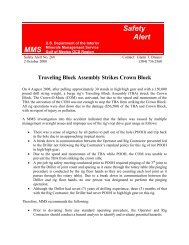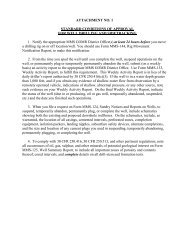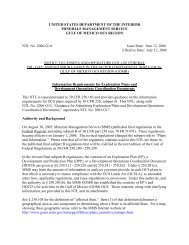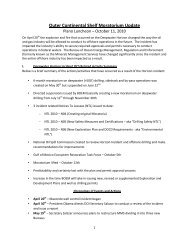Deepwater Gulf of Mexico 2004: America's Expanding ... - OCS BBS
Deepwater Gulf of Mexico 2004: America's Expanding ... - OCS BBS
Deepwater Gulf of Mexico 2004: America's Expanding ... - OCS BBS
- No tags were found...
Create successful ePaper yourself
Turn your PDF publications into a flip-book with our unique Google optimized e-Paper software.
DRILLING AND DEVELOPMENT<br />
<strong>Deepwater</strong> drilling occurs from mobile <strong>of</strong>fshore drilling units (MODU’s), such as semisubmersible units<br />
or drillships (figures 29 and 30), and from platform rigs. There are numerous deepwater prospects<br />
waiting to be drilled, and there will be many that remain undrilled before the primary lease terms expire<br />
because <strong>of</strong> the limited number <strong>of</strong> rigs available for deepwater drilling in the GOM. Figure 31 depicts<br />
deepwater rigs operating in the GOM from 1992 through 2003. 1 There was a steady increase in the<br />
average number <strong>of</strong> rigs operating from 1992 to a peak in 2001. However, in the past two years, the<br />
number <strong>of</strong> rigs operating has decreased 29 percent. Figure 32 shows the number <strong>of</strong> deepwater MODU’s<br />
by water-depth categories in the GOM and worldwide. Approximately 28 percent <strong>of</strong> the world’s fleet <strong>of</strong><br />
deepwater drilling rigs is committed to GOM service (Harding and Albaugh, 2003). The pie chart within<br />
figure 32 shows the distribution <strong>of</strong> deepwater rigs by major operating area. Most, if not all, <strong>of</strong> the<br />
deepwater-capable drilling rigs are under long-term contractual arrangements. The reader is cautioned<br />
not to draw any conclusions from the rig count differences between figures 31 and 32. As mentioned<br />
above, figure 31 includes platform rigs in addition to MODU’s; figure 32 addresses MODU’s only.<br />
Further, not all MODU’s in figure 32 are operating at any given time and upgrades to MODU’s that<br />
increase their water-depth capability will alter the rig counts shown, so year-to-year comparisons may not<br />
be valid.<br />
DRILLING ACTIVITY<br />
The number <strong>of</strong> deepwater wells drilled generally increased from 1992 through 2001; however, the activity<br />
has declined in the last two years. Only original boreholes and sidetracks are included in the well counts<br />
used in this report. Wells defined as “by-passes” are specifically excluded. A “by-pass” is a section <strong>of</strong><br />
well that does not seek a new objective; it is intended to drill around a section <strong>of</strong> the wellbore made<br />
unusable by stuck pipe or equipment left in the wellbore. Figure 33 shows that most <strong>of</strong> the drilling has<br />
occurred in the 1,500- to 4,999-ft (457- to 1,524-m) water-depth range. Despite an overall decline in<br />
recent years, considerable drilling activity occurred in water depths greater than 7,500 ft (2,286 m). It is<br />
interesting to note that, in November 2003, the first well began drilling in over 10,000 ft (3,050 m) <strong>of</strong><br />
water and more are anticipated.<br />
Figures 34 and 35 further break down the deepwater well counts into exploratory and development wells,<br />
respectively. This report uses the designation <strong>of</strong> exploratory and development wells provided by the<br />
operators. The data reflect the variations among operators in classifying wells as either development or<br />
exploratory. In the past two years, there has been a decrease in the number <strong>of</strong> exploratory wells drilled.<br />
This is best illustrated by looking at the number <strong>of</strong> wells drilled in the 1,500- to 4,999-ft (457- to<br />
1,524-m) water-depth range. While exploratory drilling at this depth is decreasing, drilling in the 5,000-<br />
to 7,499-ft (1,524- to 2,286-m) and the >7,500 ft (2,286 m) water-depth ranges is increasing. There has<br />
also been a decrease in the number <strong>of</strong> development wells drilled in the last year. Possible reasons for the<br />
recent decrease may be the method by which wells are categorized in this report (exploratory versus<br />
development), the retention <strong>of</strong> exploratory wells for production purposes, and the lag from exploration to<br />
first production. The complexity <strong>of</strong> the deepest water developments may also be a factor, requiring<br />
operators to spend more time in planning and design. Most development drilling was in the 1,500- to<br />
4,999-ft (457- to 1,524-m) water-depth range; there are no development wells in water depths exceeding<br />
7,500 ft (2,286 m).<br />
Figure 36 illustrates the geographic distribution <strong>of</strong> deepwater exploratory wells. Note the progression<br />
into the western GOM and into deeper water through time. Figure 37 depicts the locations <strong>of</strong> deepwater<br />
development wells. Once again, the data reveal a general increase in activity as well as a trend toward<br />
increasing water depth with time.<br />
1 It is important to note that the rig count includes platform rigs operating on deepwater production facilities in<br />
addition to the MODU’s. About one-third <strong>of</strong> all rigs are platform rigs. The numbers do not distinguish between rigs<br />
drilling and those in service for completion and workover operations.<br />
47







